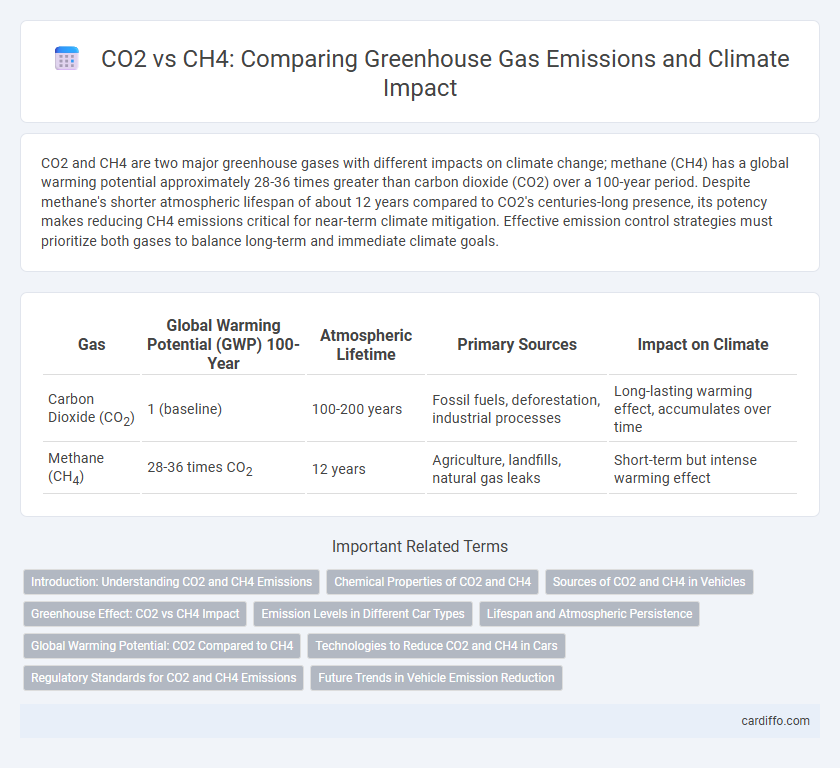CO2 and CH4 are two major greenhouse gases with different impacts on climate change; methane (CH4) has a global warming potential approximately 28-36 times greater than carbon dioxide (CO2) over a 100-year period. Despite methane's shorter atmospheric lifespan of about 12 years compared to CO2's centuries-long presence, its potency makes reducing CH4 emissions critical for near-term climate mitigation. Effective emission control strategies must prioritize both gases to balance long-term and immediate climate goals.
Table of Comparison
| Gas | Global Warming Potential (GWP) 100-Year | Atmospheric Lifetime | Primary Sources | Impact on Climate |
|---|---|---|---|---|
| Carbon Dioxide (CO2) | 1 (baseline) | 100-200 years | Fossil fuels, deforestation, industrial processes | Long-lasting warming effect, accumulates over time |
| Methane (CH4) | 28-36 times CO2 | 12 years | Agriculture, landfills, natural gas leaks | Short-term but intense warming effect |
Introduction: Understanding CO2 and CH4 Emissions
CO2 and CH4 are two major greenhouse gases contributing to global warming, with CO2 primarily released through fossil fuel combustion and deforestation, while CH4 emissions stem from agriculture, landfills, and natural gas production. Methane (CH4) has a global warming potential approximately 28-36 times greater than carbon dioxide (CO2) over 100 years, making it a critical target for emission reduction strategies despite its lower atmospheric concentration. Understanding the differing sources, lifetimes, and impact of CO2 and CH4 is essential for developing effective climate mitigation policies.
Chemical Properties of CO2 and CH4
CO2 (carbon dioxide) is a linear molecule with two double bonds between carbon and oxygen atoms, making it chemically stable and less reactive under standard atmospheric conditions. CH4 (methane) is a tetrahedral molecule with four single C-H bonds, characterized by a strong symmetry and a higher potential for oxidation, resulting in greater energy release during combustion. The molecular structure of CH4 leads to a higher global warming potential compared to CO2, despite its shorter atmospheric lifetime.
Sources of CO2 and CH4 in Vehicles
Vehicles contribute significantly to greenhouse gas emissions, with CO2 primarily released from the combustion of gasoline and diesel fuels in internal combustion engines. Methane (CH4) emissions in vehicles are less prevalent but arise from incomplete fuel combustion and leakage in natural gas-powered engines. Understanding these sources is crucial for developing targeted strategies to reduce vehicular impact on climate change.
Greenhouse Effect: CO2 vs CH4 Impact
Methane (CH4) has a global warming potential approximately 28-36 times greater than carbon dioxide (CO2) over a 100-year period, making it a significantly more potent greenhouse gas despite its lower atmospheric concentration. While CO2 remains the largest contributor to long-term climate change due to its abundance and persistence, CH4's impact on short-term warming is considerably stronger because it absorbs more infrared radiation per molecule. Targeting methane emissions can therefore provide rapid climate benefits, whereas CO2 mitigation is essential for sustained climate stability.
Emission Levels in Different Car Types
Gasoline cars emit higher levels of CO2 compared to methane (CH4), primarily due to the combustion of fossil fuels. In contrast, natural gas vehicles release significantly lower CO2 but may emit small quantities of methane, a potent greenhouse gas, through fuel leakage. Electric vehicles produce negligible tailpipe emissions, reducing overall CO2 and CH4 impacts during operation.
Lifespan and Atmospheric Persistence
Methane (CH4) has a shorter atmospheric lifespan of approximately 12 years compared to carbon dioxide's (CO2) much longer persistence, which can last from centuries to millennia. Despite its shorter lifespan, methane has a global warming potential over 20 times greater than CO2 over a 100-year period. This difference in atmospheric persistence highlights the urgency to manage methane emissions for near-term climate mitigation while addressing carbon dioxide for long-term environmental stability.
Global Warming Potential: CO2 Compared to CH4
Methane (CH4) has a global warming potential (GWP) approximately 28-36 times greater than carbon dioxide (CO2) over a 100-year period, making it a significantly more potent greenhouse gas despite its shorter atmospheric lifetime. While CO2 persists in the atmosphere for centuries, CH4 breaks down faster but traps much more heat per molecule during its active period. Understanding the GWP discrepancy between CO2 and CH4 is crucial for prioritizing emission reduction strategies to mitigate climate change effectively.
Technologies to Reduce CO2 and CH4 in Cars
Advanced catalytic converters and particulate filters significantly reduce CO2 and CH4 emissions in modern vehicles by enhancing fuel combustion efficiency and trapping unburned hydrocarbons. Electric and hybrid engine technologies eliminate direct CO2 and CH4 outputs by relying on battery power or combining internal combustion with electric propulsion for optimized fuel use. Additionally, methane oxidation catalysts specifically target CH4 emissions in natural gas vehicles, breaking down methane before it enters the atmosphere.
Regulatory Standards for CO2 and CH4 Emissions
Regulatory standards for CO2 emissions are typically more stringent due to the gas's higher volume released from fossil fuel combustion and industrial processes, with limits set by agencies such as the EPA under the Clean Air Act. Methane (CH4) regulations focus on its potent greenhouse effect, prompting policies targeting methane leaks from oil and gas operations, landfills, and agriculture, often requiring methane capture and reporting standards. Both gases are regulated under international agreements like the Paris Accord, but methane standards emphasize rapid emission reductions due to its higher global warming potential over a 20-year horizon.
Future Trends in Vehicle Emission Reduction
Future trends in vehicle emission reduction focus on significantly lowering CO2 and CH4 output through advanced technologies like electric drivetrains and hydrogen fuel cells. Improvements in catalytic converters and methane capture systems aim to reduce methane emissions from internal combustion engines. Regulatory policies targeting greenhouse gas limits will accelerate the transition to zero-emission vehicles, emphasizing the importance of both carbon dioxide and methane mitigation.
CO2 vs CH4 Infographic

 cardiffo.com
cardiffo.com